Car Suspension Basics, How-To & Design Tips cont…
Suspension Types
There are dozens of variations of suspension types used on race and passenger vehicles. Depending on the type of racing (for race cars), the road surface and evolution of the vehicles, the suspension is designed to accommodate multiple requirements. Each suspension type has its advantages and disadvantages—let’s take a look at a few of the primary types and their pros and cons.
Front Suspension Types
Beam Axle Suspension
The beam axle is just as its name would suggest—It is a beam or tube connecting the two front wheels. As shown in diagram BA1, connections to the chassis are provided by link rods (in red) which allow for vertical movement of the suspension and a lateral locating link rod (in yellow) that prevents lateral movement of the axle while still enabling vertical movement. The links are usually “Leading” links as they attach to the chassis behind the front beam axle tube.
This type of suspension provides simplicity and generally low construction costs. It lends itself well to adjusting the offset of the wheels relative to the chassis, which is useful in circle track racing. It is used today primarily in Sprint and Midget cars and in pickup trucks.
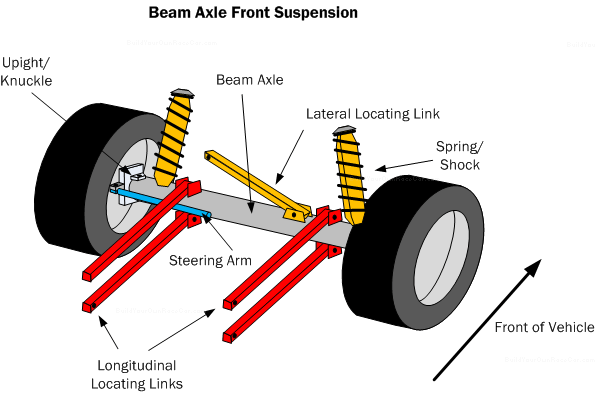
Diagram BA1. Beam axle front suspension
Beam axles excel in two areas: their ability to maintain zero camber during body roll and their ability to provide high strength. Unfortunately, the strength comes at a price of extra weight. The way the beam axle connects to the chassis has a big impact on how this suspension behaves. For instance, steering angle can change with things like road bumps if the linkage is not designed to be neutral during suspension movement. If appropriately designed, these challenges can be largely overcome.
Strut Suspension
Many production cars (especially if they have Front-drive) use the MacPherson strut suspension. The design uses a lower A-arm and the spring/shock absorber to connect the upright/knuckle to the vehicle. Both parts provide lateral and longitudinal locating while still permitting vertical movement. They are simple and relatively low cost to construct which is why Macpherson strut suspensions are used on many economy cars. However this suspension type does suffer from some disadvantages.
Diagram SS1 below shows the basic suspension layout:
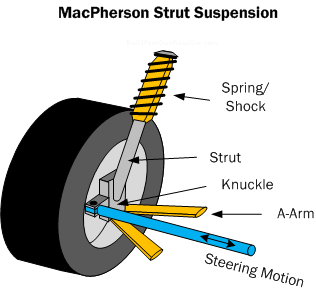
Diagram SS1. MacPherson Strut Suspension
If you put wide tires on a MacPherson strut suspension, the scrub radius increases, which in turn increases not only the overall steering effort required, but also the loading on suspension members that can lead to damage.
This suspension design also requires more vertical height to the suspension packaging due to the strut/shock, which won’t work for some vehicle designs.
Unequal Length Double Wishbone
As its name aptly describes, the unequal length double wishbone suspension, shown in diagram UEL1 below, consists of two wishbones of different lengths (The top is shorter) connected to the chassis inboard and the upright/knuckle outboard. With a good top/bottom wishbone geometry and good upright/knuckle design, this suspension type maximizes the tire contact patch by gaining camber as the vehicle body rolls. It also eliminates most of the behavior problems of other suspension designs, making it desirable when precise handling is required.
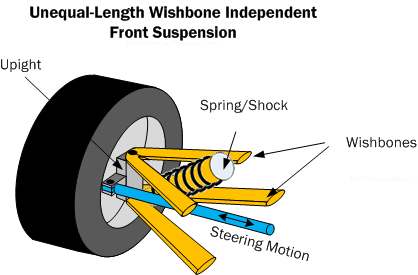
Diagram UEL1. Unequal length wishbone independent front suspension showing the steering link (blue)
The price paid for such a design is increased cost to construct, but for racing and sports cars it is very much worth the additional cost.
Rear Suspension Types
Live Axle
Used extensively in the past on rear wheel drive passenger vehicles, the Live Axle continues to be used because of its strength and simplicity. The basic design shown in diagram LA1 below uses a tube which joins the two rear wheels. In the middle is a differential that apportions power to each wheel. As with the beam axle, links or leaf springs are used to join the axle to the chassis, allowing vertical movement and controlling longitudinal and lateral movement. However, in rear axle situations, the links are usually considered “Trailing” (They mount to the chassis in front of the axle)
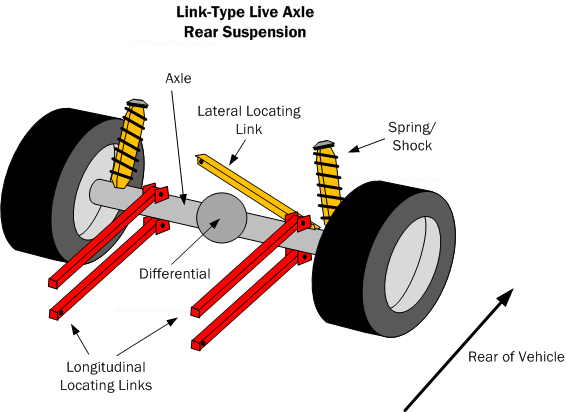
Diagram LA1. Live axle rear suspension
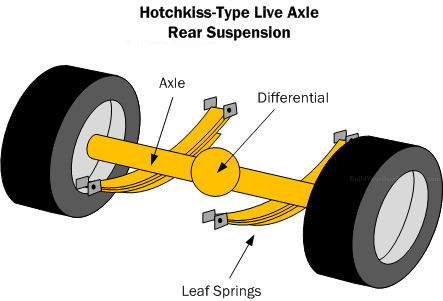
Diagram LA2. Hotchkiss-type live axle rear suspension.
Several sub-types of Live Axle suspension exist, with each differentiated by the way they connect to the chassis and the approach they use to managing suspension behavior.
Hotchkiss Drive suspensions (as shown above in diagram LA2 above) use leaf springs to locate the axle and support the vehicle. Separate shocks are used to dampen oscillations.
Link suspensions (Diagram LA1) use links that allow suspension movement vertically, but limit that movement longitudinally (front-back) and laterally (left-right).
Torque arms suspensions use a long arm compared with link type suspensions, which enables the torque applied to the axle to be controlled in a different manner.
All these sub-types (and more) essentially try to keep the wheels planted on the ground, as free of oscillations and wheel hop as possible, and as straight and true with the direction of the vehicle as possible.
Unequal Length Double Wishbone
Just as with front suspension, the unequal length double wishbone suspension can be used for rear wheels. The flexibility in the design of the suspension geometry allows the rear suspension to be matched to the front suspension, and each wheel tuned independently.
When used as a driving wheels suspension, the upright/knuckle is connected to a half drive shaft (As shown below in diagram UEL2) with an outboard CV (Constant velocity) joint that rises and falls with the wheel.
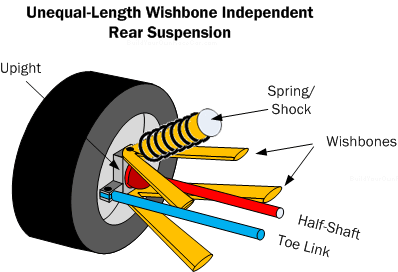
Diagram UEL2. Unequal length wishbone independent rear suspension showing a toe link and half-shaft/CV-joint outboard.
Suspension Design Tips (4/4)
Protect the driver from the suspension
In vehicles where wheels and suspension can enter the vehicle when broken (i.e. Driver situated beside suspension mounts), safety can be increased through anti-intrusion panels that will deflect broken wishbones or links.
Radial vs. Bias ply tires and Camber
Radial tires are more tolerant of static negative camber, or camber that is built into the suspension. If the suspension’s range of motion is substantial (more than 2 or 3 inches of bump travel, and 2 or 3 inches of dip), then using more negative camber to compensate for a positive change introduced by the suspension helps. Radial tires will work better with this situation.
Recommended Further Reading
Chassis Engineering: Chassis Design, Building & Tuning for High Performance Handling Chassis Engineering is a great introduction to race car design. In a practical and down-to-earth way, it covers the fundamentals of how race cars handle and the requirements for designing and constructing a car. The book includes chapters on chassis design, suspension design, frame construction, aerodynamics and tuning. Overall it provides the reader with the foundation of how the key components of a race car work and interact together.
Get "Chassis Engineering: Chassis Design, Building & Tuning for High Performance Handling":



Competition Car Suspension: A Practical Handbook Explains race car suspensions theory and design. The author explains the history of suspension design and types, handling theory, suspension design techniques, and the math/calculations used in design. The book also includes a unique string-based model approach to hands-on visualization of suspension movement.
Get "Competition Car Suspension: A Practical Handbook":



- View all suspension books
Continue on to Car Chassis Basics, How-To & Design Tips…
34 1 45 2

